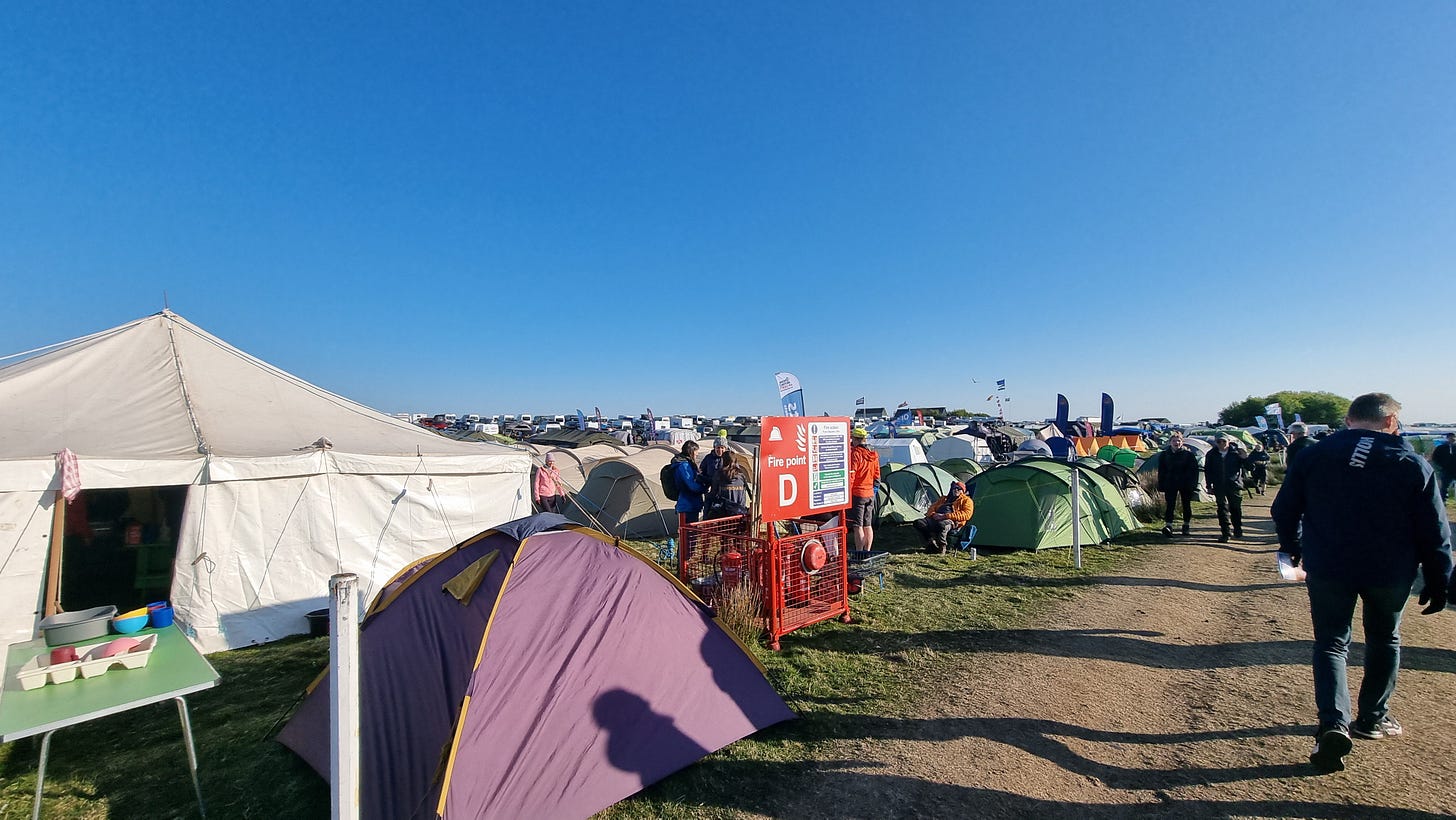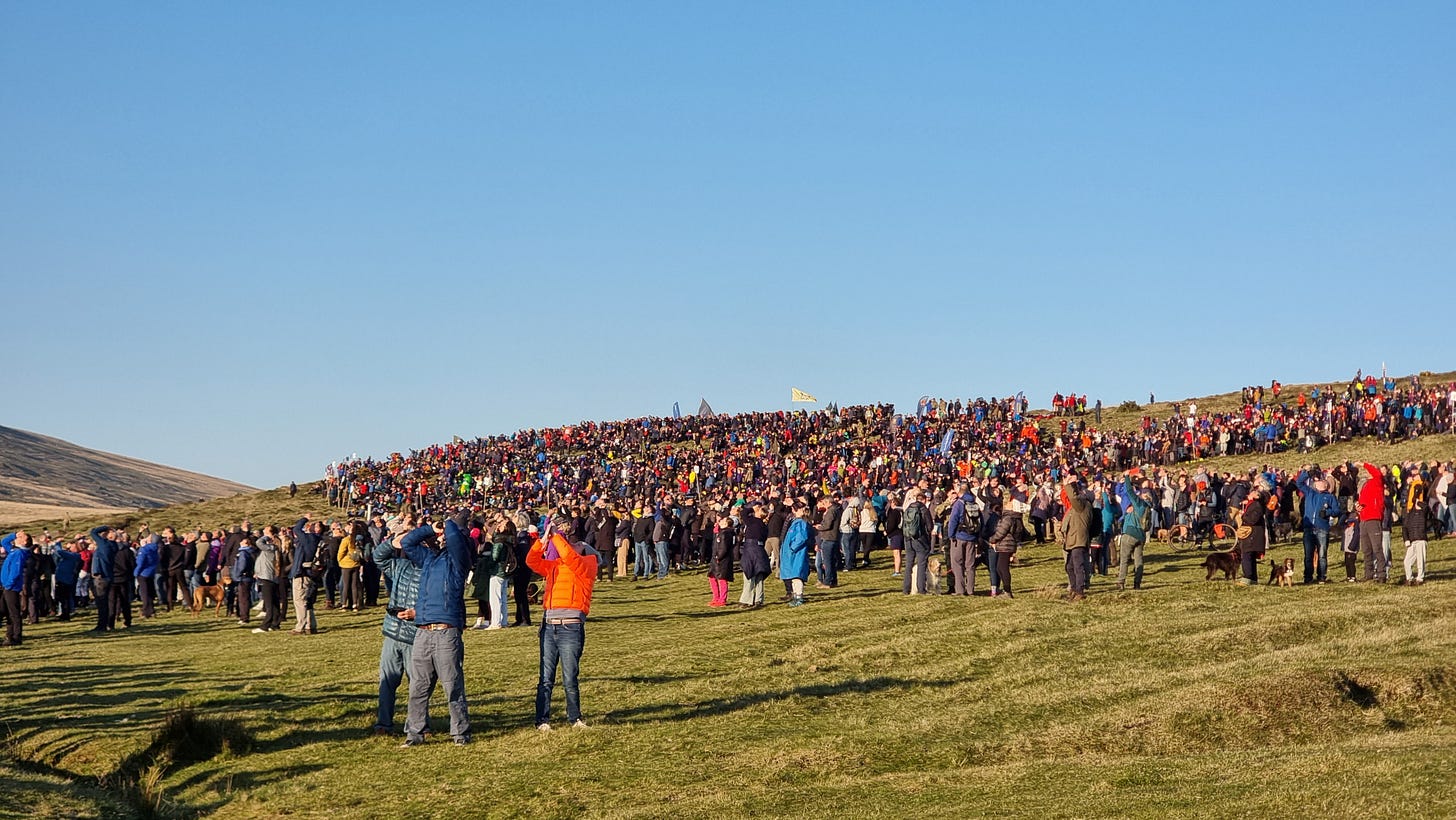Before moving to Devon, I’d heard of the Ten Tors Challenge only in passing. I vaguely remember news reports over the years of dramatic army-led evacuations of cold, soaked teenagers after extreme weather conditions during some walking event somewhere. That was about it.
After moving to Devon, I quickly realised just how big a deal it was. Friends with older kids spoke of it like a rite of passage – some had even done it themselves back in their school days.
The Ten Tors Challenge is an annual event for 14 to 19-year-olds, organised by the British Army. It began in 1960, and teams of six attempt a self-supported trek across Dartmoor, covering 35, 45 or 55 miles (depending on their age) over two days, visiting ten tors (the rocky peaks that give Dartmoor its unique landscape) along the way. They carry all their kit and navigate themselves. No GPS. No mobile phones. Just compass, map, determination, and teamwork.
I assumed it was a thing for scout groups or army cadets, and none of our children has ever been involved in these groups. So, it was a surprise when Leo – aged 14 – came home from school one day last year and casually announced he’d signed up to this year’s Ten Tors Challenge.
Since then, he’s spent six months training. There have been weekly after-school sessions in navigation and map reading and at least five or six full training weekends on Dartmoor, some in the middle of winter, battling wind, rain, and endless mud. And he’s really loved it. We’ve seen a different side of him. For a teenager who’s not known for voluntarily trading his screen time for outdoors time, it has been a dramatic shift.
On Friday last week, Leo and about 35 others from his school were taken by bus to the army base at Okehampton on the northern edge of Dartmoor, where they joined up with thousands of other teenagers from various schools and youth groups from across the South West. They spent the day plotting their routes, preparing all their gear, and hoping they wouldn’t be picked for a random ‘scrutineering’ search of their backpacks by the army. Then it was dinner, a final kit check, and an early night in tents.
I’d heard it was quite a spectacle to go and watch your child finish the event on the Sunday, but it wasn’t until a few days before that a friend told me how great the start was too.
‘But they start at 7 am. In North Devon,’ I’d said, not too excited about the prospect of getting up so early.
‘I know but it’s well worth the trip,’ my friend had promised.
So Rachel and I woke at 4 am on Saturday and were on the road by 4.30 am.
The Ten Tors website advised getting there at around 6 am because of potential traffic delays, so when we pulled into Okehampton at 5.45 am, Rachel and I both felt pretty smug having got there with so much time to spare.
And then we turned the corner to drive the final 1.5 miles up the hill to Okehampton Camp and saw hundreds of taillights of cars backed up along the road.
Ten minutes later, we hadn’t moved an inch.
We eventually shuffled forwards a little but at this speed, there was no way we would make the start. As other people ahead of us were doing, we pulled off into a side street and decided to walk. Typically, as we got back to the main road, it was flowing freely, so we hurried back to the van and re-joined the queue, only for it to grind to a halt again.
‘What do we do now?’ asked Rachel.
‘Why don’t you walk?’ I suggested. ‘At least then one of us will get to see it.’
‘But you might miss it.’
‘Hopefully I’ll still get there in time, but it’s better for one of us to miss it than both.’
Rachel began walking and then five minutes later I picked her up as the traffic began moving again. From then on, we crawled steadily up the narrow lane to Okehampton Camp, arriving at about 6.40 am.
We were directed into a vast moorland field on the edge of the camp, and then walked the half mile towards the start, through fields of tents and marques – each school or youth group with its own HQ, some complete with sofas and armchairs. The logistics of coordinating it all was staggering. Like a mini-Glastonbury. And this had just been for the Friday night. An hour earlier, this campsite would have been buzzing with thousands of teenagers and group leaders having their breakfast and getting ready. Now it was eerily quiet.
Continuing through the deserted camp, past fast-food trailers and rows of portable toilets, we reached the crest of the hill at the top of the army camp.
Goosebumps spread across my skin and I instantly felt choked up. Spread out before us was Dartmoor in all its moody glory – and gathered on the opposite hillside were thousands of teenagers, standing shoulder to shoulder in their teams. Waiting.
Somewhere in that crowd was Leo.
I tried to say something to Rachel but no coherent words came out, so I just did a weird cough instead.
We had arrived just in time. Seconds later, they announced the arrival of the Red Devils Army Parachute Display Team. All eyes turned skywards as one by one they exited the plane, thousands of feet above us, twisting and looping in formation, drawing patterns in the sky with their smoke flares, and one of them trailing a giant Union Jack flag.
I had told Rachel about a video I’d seen of a previous Ten Tors where a cannon was brought in by helicopter for the start. Having seen the parachutist with the flag, Rachel got a little confused.
‘Is someone going to parachute down attached to a cannon?’ she asked
I burst out laughing.
‘No, I hope not! I don’t think that would end well. It’s just lowered down from a helicopter, I think.’
‘Oh good, that’s a relief. I was worried for a minute.’
The cannon wasn’t helicoptered in this year. But the cannon was there – fired in dramatic style to signal the start of the challenge. Before that, the Head of the British Army – General Sir Roland Walker – delivered a stirring speech about courage, resilience, and the adventure that lay ahead. This was a moment these 2,400 teenagers – and the thousands of spectators – would remember for the rest of their lives.
We found out from Leo the next day that none of the teams near to him had been able to hear a single word that the General had said over the PA system. But us spectators found it moving anyway.
The cannon fired, helicopters did a flyby, and 2,400 teenagers raced off in different directions onto the moor.
Some teams made a show of it and sprinted from the start. It’s not a race, but it sort of is. Each group is assigned one of 26 different routes, and the way they navigate between their required tors and checkpoints is up to them, so no two teams walk the exact same route or distance.
Twenty minutes later, they were all out of sight.
Rachel and I wandered back through the camp to Leo’s school’s HQ to see if any of the teachers or other parents were there, but the place was still deserted.
We had our own big adventure planned for the day (more on that next week). Rather than risk getting stuck in traffic driving back down into Okehampton and then back up to the camp for the finish on Sunday, we decided to leave the van where it was and sleep in it overnight. This proved to be a wise decision. The next day, we heard horror stories of families stuck for four hours trying to drive the final two miles to the finish line, with many of them missing seeing their children cross the line.
The parking field held hundreds of cars, and I had assumed many others would be camping overnight too. We returned from our day’s adventure just after sunset, and there were just two other vehicles in the now-locked field – both were unoccupied. We climbed the gate, stealthily slid the van door closed and hoped that the neighbouring army camp full of soldiers wouldn’t notice us sleeping in the car park.
Our van is not a campervan. The seats do not fold into a bed. Rachel and I each claimed a row and tried to sleep across them, seatbelt buckles jabbing into our sides. When my friend Mark and I travelled across the US (as featured in Not Tonight, Josephine), this was how we spent most nights. And I don’t remember it being so bad. But now a lot older, on the eve of my 46th birthday, and after a pretty arduous day (more on that next week 🤫), we both had a horrendous night’s sleep.
We woke early the next morning, desperate to end the discomfort. Rachel had brought the makings of a birthday breakfast, and prepared bacon, eggs and sausage sandwiches, while I made tea and coffee, cooked discreetly next to the van.
Just as we had finished packing away, the army opened the car park gates and the cars began flooding in.
We returned to Leo’s school’s HQ and chatted to the teachers and helpers and checked in on the teams’ progress. Leo’s team was estimated to finish about 2 pm. One of the volunteers had been a former teacher at the school and had been their Ten Tors coordinator for many years. He then retired and took a year off but missed the Ten Tors so much that he came back the following year to volunteer with the school, and every year after. This was his 53rd annual Ten Tors Challenge. I doubt there are many others who would know the event or the moor better than him.
There have been some pretty dramatic Ten Tors Challenges over the years. When the event began in 1960, they were blessed with six years of perfect conditions. Then in 1967, dense fog settled across the moor. Over 100 participants were still stranded on the moor on the Monday morning.
In 1996 a heavy snow blizzard forced a mass evacuation of teams on the Sunday afternoon.
In 2007, the event was abandoned on the Saturday night, and all teams were evacuated after heavy rain caused the streams and rivers to swell to many times their usual size. In other years (such as this year) the weather had been too good, and heatstroke has been a real issue. We heard reports of many people having to pull out of this year’s challenge or be airlifted because of the heat.
At about 9 am, we made our way to the finish line and watched some of the earlier teams complete their challenge. It then began raining heavily so we went back to the van, put on a few more layers, made a flask of tea, and returned to the finish. The rain stopped, the sun came out and we sat and watched for another four hours.
It was amazing seeing the different teams cross the line. Some wore fancy dress – tutus, wigs, hats, sunglasses. Some laughed and cheered, others had faces fixed with quiet determination. A few looked completely broken. Some looked utterly miserable. But every one of them looked like they’d achieved something special.
All teams begin as a six and could continue as long as there were four of them. Some teams had depleted over the weekend and crossed the line as a five or four. We heard occasional requests over the PA system for group leaders to attend the ‘abandonment centre’ which meant some of their participants had been returned by helicopter or rescue vehicle.
At 2.40 pm, Leo and his team appeared. All six of them together – three boys and three girls – arms linked and wearing flower garlands, tutus and a unicorn horn each. More importantly, they all had big grins spread across their faces.
Everyone who completes the Ten Tors Challenge gets a medal and a pasty, which is a proper West Country reward. But they left with far more than that – pride, confidence, a load of new skills, and a story they’ll tell for the rest of their lives.
In my post – Stealing Souls – Part Two – I wrote briefly about some teenagers we saw training for their Duke of Edinburgh Awards.
Throughout the day, we passed about a dozen groups of teenagers, each heavily laden with backpacks, maps, and compasses, as they tackled their Duke of Edinburgh expeditions. Our son Leo was also on a training walk in the southern part of the moor, preparing for one of his own expeditions.
Seeing so many young people embracing the challenge and adventure of being out on the moor was heartening. Experiences like these are so important for developing resilience, teamwork, and a love of the outdoors. Watching them navigate their way across the rugged terrain – and smiling and laughing while they did it – filled me with a lot of hope for the future.
The Ten Tors Challenge was such an inspiring weekend. I would love to go to spectate again, even if I don’t have a child taking part. Watching those teenagers rise to the challenge, seeing the effort, teamwork, and determination in every face that crossed the finish line was truly wonderful. We often worry about the youth of today, but spend a weekend at Ten Tors and you’ll come away feeling very differently.
The benefits of these kinds of experiences are immeasurable. But sadly, they’re not equally available to all. They rely on schools having the funding and, more importantly, dedicated staff and volunteers willing to give up weekends and evenings to train and support these young people. Leo’s school is very fortunate that it does. Many others don’t.
This needs to change. Because this sort of challenge shouldn’t be a privilege. It should be a rite of passage available to anyone who wants it. And judging by the waiting lists of the teams that take part, lots of young people want it.
We need to give more young people the chance to get lost (and found) on a moor, soaked to the skin, eating boil-in-the-bag-breakfast, and emerging from it stronger, prouder… and possibly wearing a unicorn horn.
*** Clicking that ❤️ below gives the algorithms a friendly nudge, helping more people discover this post. If you enjoyed it, feel free to share or restack - it guarantees happiness and good fortune for the rest of your day. (Guarantee may be purely coincidental, but why risk it? 🤞) ***



















That has made me well up! I have volunteered for years to support Duke of Edinburgh award expeditions at all the schools I've worked at. The Ten Tors sounds like a whole other level of challenge and it's remarkable that 2,400 teenagers participate. I wholeheartedly agree that these kinds of expedition should be open to all.
A wonderful story of courage and determination - well done Leo! You are inspirational, and I loved reading about this xx